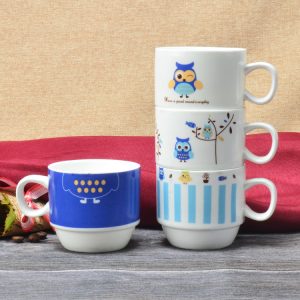Printing mugs has several processes:
1. Screen printing (for orifice printing)
Advantage:
The plate making is convenient, the price is cheap, and the batch printing is easy to control. It is suitable for LOGO with 1-4 different colors. It is especially suitable if the quantity is not large and the ink color needs to be thick. It is not limited by the texture of the load-bearing product, and has small embossing force; it has strong light resistance and is not easy to fade; the adhesion is strong, and the printed pattern has a three-dimensional effect.
Disadvantages:
Screen printing is only suitable for single color, simple transition color, color gradient effect or too rich color cannot be screen printed.

2. Hot stamping (also called embossing) commonly known as hot stamping
The surface of the gift is hot and colored, such as text and pattern (with color), colorless hot stamping, monochrome hot stamping, hybrid hot stamping and overprinting.
Advantage:
The pattern is clear, the surface is smooth and flat, the lines are straight, beautiful, colorful and dazzling, modern; wear-resistant, weather-resistant, with many colors and patterns, and can be customized according to specific requirements.
Disadvantages:
The disadvantage of hot stamping is that it requires high temperature and high pressure, and even for a long time under high temperature and high pressure, for some patterns, it can only lead to incomplete displacement of the polymer, that is, the cavity of the stamp cannot be completely filled.
3. Thermal transfer
Advantage:
It is especially suitable for making a small variety of personalized and customized products, as well as printing patterns containing full-color images or photos. It can be used for digital printing machines with disposable multi-color, arbitrarily complex color and transition color printing on any relatively flat material such as leather, textile fabric, plexiglass, metal, plastic, crystal, wood products, coated paper, etc. , rich in layers, small color difference and so on. Ideal for photo printing that requires color transitions.
Disadvantages:
Not all products can be printed by thermal transfer, which involves factors such as heat resistance and smoothness of the product. Need professional thermal transfer equipment, for ceramics, metal and other items need to have a thermal transfer layer on the surface.

4. Water transfer
A printing method in which a transfer paper/plastic film with a color pattern is subjected to macromolecular hydrolysis by water pressure.
Advantage:
The production cost is low, and the inkjet water transfer is suitable for a small number of pictures (one can be done), a complicated picture, and a variety of pictures. The transfer pattern is bright in color, rich in layers, beautiful and realistic, and durable.
5. Ceramic baking flowers
Place the paper-stuffed cup into the kiln and bake it at high temperature. The key to baking flowers is temperature. The temperature is limited by the color of the paper and the material of the ceramic cup. That is, different colors need to be baked at different temperatures in order to make a better product. If the temperature is lower than the temperature required by the color, the printed pattern has no luster and the color is not bright. If the temperature is higher than the temperature required by the color, the printed pattern will become pale and white, even if it is not printed. However, the material of the ceramic cup also affects the temperature of the roasted flour, because the temperature of the roasted flour is just enough to melt the glaze on the ceramic cup. At this time, the ceramic toner on the flower paper will penetrate into the glaze, and wait until After the product is cooled down, the color and the ceramic cup are integrated, so that the ceramic cup does not fade. The coloring power is strong, the color is bright, and the three-dimensional effect is achieved, which can achieve the artistic effect of hand-drawing. The glaze coloring material is non-toxic and harmless, and the ceramic pigment of the same performance can be overprinted, and the pigments of different properties can only be overprinted, otherwise, the color is discolored under high temperature.
